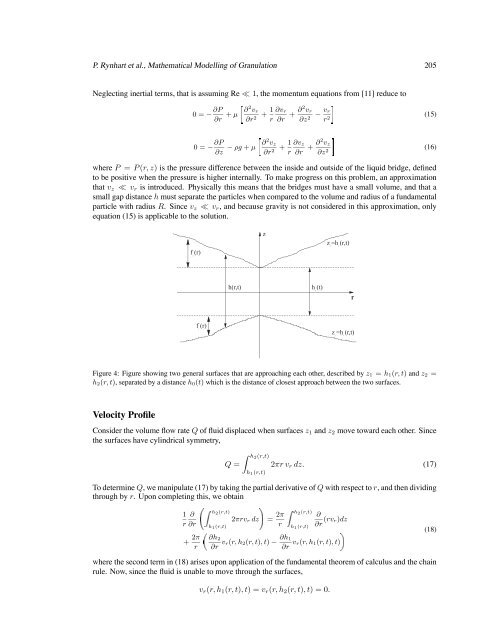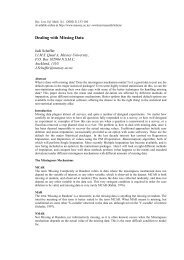Mathematical Modelling of Granulation: Static and Dynamic Liquid ...
Mathematical Modelling of Granulation: Static and Dynamic Liquid ...
Mathematical Modelling of Granulation: Static and Dynamic Liquid ...
You also want an ePaper? Increase the reach of your titles
YUMPU automatically turns print PDFs into web optimized ePapers that Google loves.
P. Rynhart et al., <strong>Mathematical</strong> <strong>Modelling</strong> <strong>of</strong> <strong>Granulation</strong> 205<br />
Neglecting inertial terms, that is assuming Re ≪ 1, the momentum equations from [11] reduce to<br />
0=− ∂P<br />
∂r + µ ∂2vr 1 ∂vr<br />
+<br />
∂r2 r ∂r + ∂2vr ∂z<br />
0=− ∂P<br />
∂z − ρg + µ ∂2vz 1<br />
+<br />
∂r2 r<br />
r 2<br />
2 − vr<br />
∂vz<br />
∂r + ∂2vz ∂z2 where P = P (r, z) is the pressure difference between the inside <strong>and</strong> outside <strong>of</strong> the liquid bridge, defined<br />
to be positive when the pressure is higher internally. To make progress on this problem, an approximation<br />
that vz ≪ vr is introduced. Physically this means that the bridges must have a small volume, <strong>and</strong> that a<br />
small gap distance h must separate the particles when compared to the volume <strong>and</strong> radius <strong>of</strong> a fundamental<br />
particle with radius R. Since vz ≪ vr, <strong>and</strong> because gravity is not considered in this approximation, only<br />
equation (15) is applicable to the solution.<br />
Figure 4: Figure showing two general surfaces that are approaching each other, described by z1 = h1(r, t) <strong>and</strong> z2 =<br />
h2(r, t), separated by a distance h0(t) which is the distance <strong>of</strong> closest approach between the two surfaces.<br />
Velocity Pr<strong>of</strong>ile<br />
Consider the volume flow rate Q <strong>of</strong> fluid displaced when surfaces z1 <strong>and</strong> z2 move toward each other. Since<br />
the surfaces have cylindrical symmetry,<br />
Q =<br />
h2(r,t)<br />
h1(r,t)<br />
(15)<br />
(16)<br />
2πr vr dz. (17)<br />
To determine Q,wemanipulate (17) by taking the partial derivative <strong>of</strong> Q with respect to r,<strong>and</strong>then dividing<br />
through by r. Upon completing this, we obtain<br />
1<br />
r<br />
∂<br />
∂r<br />
+ 2π<br />
r<br />
Z h2(r,t)<br />
h1(r,t)<br />
∂h2<br />
∂r<br />
! 2π<br />
2πrvr dz =<br />
r<br />
Z h2(r,t)<br />
h1(r,t)<br />
∂<br />
∂r (rvr)dz<br />
∂h1<br />
vr(r, h2(r, t),t) − vr(r, h1(r, t),t)<br />
∂r<br />
where the second term in (18) arises upon application <strong>of</strong> the fundamental theorem <strong>of</strong> calculus <strong>and</strong> the chain<br />
rule. Now, since the fluid is unable to move through the surfaces,<br />
vr(r, h1(r, t),t)=vr(r, h2(r, t),t)=0.<br />
(18)








